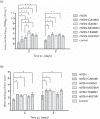In vitro and in vivo replication of influenza A H1N1 WSN33 viruses with different M1 proteins
- PMID: 23255622
- PMCID: PMC3709687
- DOI: 10.1099/vir.0.046219-0
In vitro and in vivo replication of influenza A H1N1 WSN33 viruses with different M1 proteins
Abstract
The M1 protein is a major structural protein that has multiple functions in various steps within the life cycle of the influenza A virus (IAV). However, little is currently known about the role of M1 in IAV replication in vivo and the associated pathogenesis. In this study, six isogenic H1N1 WSN33 viruses, constructed to express unique M1 proteins derived from various strains, subtypes or WSN33 itself, were tested to determine in vitro and in vivo functional exchangeability of M1 proteins in the replication and pathogenesis of the WSN33 virus. Despite five chimeric M1 viruses replicating to levels similar to those of the parental WSN33 virus in cell cultures, all M1 chimeras exhibited improved replication and enhanced virulence in mice when compared with the WSN33 virus. Interestingly, M1 proteins derived from swine viruses caused more severe clinical diseases than those from human or quail. These data indicate that the M1 protein is an important determinant of viral replication and pathogenic properties in mice, although the functions of M1 observed in vivo are not adequately reflected in simple infections of cultured cells. Chimeric M1 viruses that are variable in their clinical manifestations described here will aid future understanding of the role of M1 in IAV pathogenesis.
Figures







Similar articles
-
Key Amino Acids of M1-41 and M2-27 Determine Growth and Pathogenicity of Chimeric H17 Bat Influenza Virus in Cells and in Mice.J Virol. 2021 Sep 9;95(19):e0101921. doi: 10.1128/JVI.01019-21. Epub 2021 Sep 9. J Virol. 2021. PMID: 34287044 Free PMC article.
-
Palmitoylation of the influenza A virus M2 protein is not required for virus replication in vitro but contributes to virus virulence.J Virol. 2009 Sep;83(17):8655-61. doi: 10.1128/JVI.01129-09. Epub 2009 Jun 24. J Virol. 2009. PMID: 19553312 Free PMC article.
-
PB2 residue 158 is a pathogenic determinant of pandemic H1N1 and H5 influenza a viruses in mice.J Virol. 2011 Jan;85(1):357-65. doi: 10.1128/JVI.01694-10. Epub 2010 Oct 20. J Virol. 2011. PMID: 20962098 Free PMC article.
-
The R251K Substitution in Viral Protein PB2 Increases Viral Replication and Pathogenicity of Eurasian Avian-like H1N1 Swine Influenza Viruses.Viruses. 2020 Jan 2;12(1):52. doi: 10.3390/v12010052. Viruses. 2020. PMID: 31906472 Free PMC article.
-
Virulence of pandemic (H1N1) 2009 influenza A polymerase reassortant viruses.Virulence. 2011 Sep-Oct;2(5):422-6. doi: 10.4161/viru.2.5.17267. Epub 2011 Sep 1. Virulence. 2011. PMID: 21921678 Review.
Cited by
-
A comparison of RSV and influenza in vitro kinetic parameters reveals differences in infecting time.PLoS One. 2018 Feb 8;13(2):e0192645. doi: 10.1371/journal.pone.0192645. eCollection 2018. PLoS One. 2018. PMID: 29420667 Free PMC article.
-
Amphotericin B Inhibits Enterovirus 71 Replication by Impeding Viral Entry.Sci Rep. 2016 Sep 9;6:33150. doi: 10.1038/srep33150. Sci Rep. 2016. PMID: 27608771 Free PMC article.
References
Publication types
MeSH terms
Substances
Grants and funding
LinkOut - more resources
Full Text Sources
Other Literature Sources

